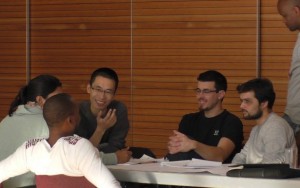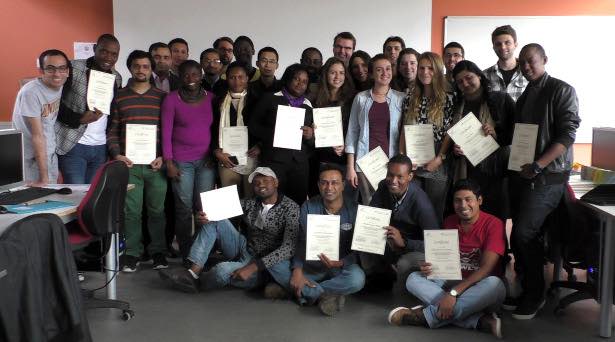On the last weekend, the Summer Academy ended. In this post, we want to share some experiences and insights.
In the second half of the first week the students were taught by three different external lecturers. Wednesday and Thursday they had the privilege to hear from Yvonne Waltz and Zita Sebesvari from the United Nations University in Bonn. Zita Sebesvari discussed the vulnerability aspects of chemical contamination which is the cause effect relationships between chemical contamination and the resilience of coupled social-ecological systems. Particularly, the students looked at root causes of the pollution, vulnerability of ecosystem services influenced by pollution, and resulting changes in the resilience of the coupled social-ecological systems as affected by the pollution. Methods of vulnerability assessment were taught as well as aspects of pesticide use assessment, possible exposure pathways to pesticides, vulnerabilities caused by degraded ecosystem services as far as the degradation was linked to the pollution; linking typical exposure pathways with social groups.
Earth-to-Space-based Observing Systems for Environmental Risk Assessment and Disaster Management was taught by Yvonne Waltz, she introduced the students to a number of global and regional, in-situ and space based observing systems around the world (all of them essentially contributing to the continuous monitoring of environmental risks and hazards). Additionally, major mechanisms to access space based information and GIS specifically dedicated to support all phases of crisis management were presented to the students.
The first week was rounded off by James Dabrowski from The Council for Scientific and Industrial Research (CSIR) in South Africa. He lectured on Risk assessment and data availability in a developing country. This module presented real situations in developing countries using South Africa as a case study. The students learnt a specific approach for risk assessment, the development of exposure maps and possible classification of pesticides in risk categories to set priorities in the subsequent monitoring and risk assessment. This was done by paying particular attention to the optimal allocation of the limited resources available in developing countries.
Over the week the students had the opportunity to participate in a few cultural experiences. Wednesday night they went to sample some of the wine that this region is so famous for and over the weekend the group got to see the beautiful city of Heidelberg as well as participate in a Rhine river cruise, where the wildlife was pointed out by a very knowledgeable guide. The students all seemed to thoroughly enjoy their cultural experiences and said that their weekend tours were quite relaxing.
In the second week of the Summer Academy the students were introduced to varying open source software applications such as R and GRASS GIS to use in spatial analyses and mapping by Ralf Schäfer. The first topic of the second week, taught by Avit Bhowmik, was to use this aforementioned software to conduct spatial analyses and create simplified pesticide exposure maps for regions with data scarcity. The students learnt to process free global satellite and ecological data and used this information to characterize chemical exposure risks. Given the limited availability of data in developing countries, a special emphasis was placed on spatio-temporal interpolation techniques that can be used to fill in gaps in the data. After this, the students learnt how to use open source software to conduct Health Risk Mapping.
Later in the week, the theoretical basics on the topics of agricultural practice and modelling of pesticide contamination were presented by Engelbert Niehaus, Jörg Rapp, and Melanie Platz and then practiced. After, the students were able to create contamination maps using open-source software and relate them to other relevant variables such as population density or land use. The last day of the course combined the skills that the students had developed during the course and applied them to a real world situation: they had to practice specific approaches to risk assessment, to develop exposure maps and to classify pesticides in risk categories in order to set priorities in the subsequent monitoring and risk assessment in countries with limited monitoring resources.
After the hard work was finished, the students celebrated with a rather kick-ass BBQ, although due to weather restrictions, it turned out to be an indoor BBQ. After everyone had taken part in the international BBQ, where all the students prepared dishes from their home countries a spontaneous dance party erupted in the conference room. Great fun was had by all, with a variety of new dance moves displayed on the dance floor as the students from different countries showed off how they kick it in clubs from their home countries.
On the last Saturday, the students took a short trip to Wissenbourg just over the border in France. They enjoyed one of the last sunny days of the palatinate summer with a short tour of the small picturesque town and a relaxing french coffee. Some used the chance to enjoy french pastries! Saturday night ended in a spontaneous group meeting at the Herbst Markt in Landau where the group of students sat and enjoyed each other’s company and some “Weinschorle”. Sunday everyone headed off in their own directions, some either to explore a little more of Europe and others headed back to their home countries. All in all the students said they enjoyed their time in Germany and learnt a lot to take back with them.
Thanks to all participants, lecturers, and helpers for a great time, while already looking forward to next year!




